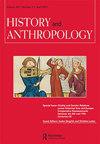Thriving in modernity: Crisis and mimesis in the life-experiences of Padre Pio and Ernesto De Martino
IF 0.4
2区 历史学
Q3 ANTHROPOLOGY
引用次数: 0
Abstract
ABSTRACTThis article examines the life experience of and the enduring devotion for Padre Pio (1887–1968) – a Capuchin friar and the most popular saint of twenty-first century Catholicism – through the work and conceptual toolkit of anthropologist Ernesto De Martino (1908–1965), one of the most talented intellectuals of twentieth century Italy. Southern Italian neighbours, De Martino conducted ethnographic research on magic and popular religiosity there just as the popularity of Padre Pio exploded out of southern Italy across the globe. The main argument of this article is that De Martino's insights on mimesis and repetition shed light on the life-experience of Pio and the enduring success of his cult, owing to a combination of social, cultural, and psychological factors that thrive from within modernity. In addition, the article shows how the work of De Martino is relevant to scholars across disciplines – historians, anthropologists, sociologists – who are investigating the relationship of society, religion and the sacred.KEYWORDS: CrisisimitationErnesto De Martinomodernity and traditionPadre Pio AcknowledgementsI would like to thank the anonymous peer reviewers of History and Anthropology, for their challenging criticism and constructive remarks, Kristina Stoeckl, Marco Martino, Bjørn Thomassen and Joseph Viscomi, for their generous and helpful comments and illuminating advices on this piece, and Mike Bluett, who edited and proofread the manuscript with creativity and scrupulous care.Disclosure statementNo potential conflict of interest was reported by the author(s).Notes1 According to a 2001 poll, 53% of Italians said that they would turn their faith first to Padre Pio in dire circumstances; see Messori Citation2001.2 The expression is from Max Weber.3 See now De Martino Citation2015; the work of anthropologist George Saunders is one of the few attempts to bring De Martino into the English-speaking world; Saunders Citation1993; see also Zinn Citation2015; Geisshuesler Citation2021.4 The notion of ‘reading experience’ indicates the formative ‘encounter’ with ‘a certain work that struck a chord with personal experiences’, generating an intellectual and existential drive (Szakolczai Citation1998, 212).5 The apostolic visitor (Monsignor Carlo Maccari) left San Giovanni unimpressed by Pio and horrified by the cult that surrounded him, which he described as ‘idolatry and perhaps even heresy … superstition and magic'. He nonetheless acknowledged his extraordinary magnetic attraction; Luzzatto Citation2010, 276.6 Tarantismo continued to be practiced until the 1960s, when it slowly declined. It is now popular as a doorway to personal happiness and health; see Del Giudice Citation2005.7 Three of the Gospels narrate that a man called Symon, from the town of Cyrene (a Greek city in the province of Cyrenaica, today's Eastern Libya), was compelled by the Romans to carry the cross of Jesus on his way to crucifixion. The Cyrenean is therefore the symbol of the embrace of divine grace and human effort. ‘Cyrenean’ is the word used in the title of the biography of Pio written by Da Ripabottoni (Citation1974); a condensed edition of which was later produced under the same title, also translated into English in 1987 as Padre Pio of Pietrelcina: Everybody's Cyrenean.8 On the role of media in bridging Pio's thaumaturgical healing with the official processes of the Catholic Church see Bartocci and Littlewood Citation2004.9 See, in a comparative vein, McDannell Citation1995, 41; Coleman and Elsner Citation1995, 6; see also Mesaritou Citation2012; 107.10 See again Mancini Citation2004, 350–353; on the opposition between ‘relative’ and ‘absolute’ health see Sabbatucci Citation1982; see also Mancini Citation1992.11 De Martino's study on the tarantula ritual in Apulia is titled La terra del rimorso. ‘Rimorso’ can be both ‘regret’ and ‘re-bite’ (a ‘morso’ is a bite).繁荣于现代性:皮奥神父与德马蒂诺人生经历中的危机与模仿
摘要本文通过20世纪意大利最有才华的知识分子之一、人类学家埃内斯托·德·马蒂诺(1908-1965)的著作和概念工具,考察了僧帽会修士、21世纪天主教最受欢迎的圣人皮奥神父(1887-1968)的人生经历和对他的持久奉献。意大利南部的邻居,德·马蒂诺在那里进行了关于魔法和大众宗教信仰的人种学研究就像神父皮奥在意大利南部风靡全球一样。本文的主要论点是,De Martino对模仿和重复的见解揭示了Pio的生活经历以及他的邪教的持久成功,这是由于现代性中蓬勃发展的社会,文化和心理因素的结合。此外,这篇文章还展示了De Martino的工作是如何与各个学科的学者——历史学家、人类学家、社会学家——相关的,这些学者正在研究社会、宗教和神圣的关系。感谢《历史与人类学》的匿名同行审稿人提出的具有挑战性的批评和建设性的评论,感谢Kristina Stoeckl、Marco Martino、Bjørn Thomassen和Joseph Viscomi对本文慷慨而有益的评论和有启发意义的建议,感谢Mike Bluett以创造性和一丝不苟的态度编辑和校对了本文的手稿。披露声明作者未报告潜在的利益冲突。注1根据2001年的一项民意调查,53%的意大利人表示,在危急情况下,他们会首先将信仰转向皮奥神父;参见Messori Citation2001.2这个表达来自马克斯·韦伯。3参见De Martino Citation2015;人类学家乔治·桑德斯(George Saunders)的著作是为数不多的将马蒂诺带入英语世界的尝试之一;桑德斯Citation1993;参见Zinn Citation2015;“阅读体验”的概念表明,与“某种与个人经历产生共鸣的作品”形成的“相遇”,产生了一种智力和存在的驱动力(Szakolczai citation1998,212)这位使徒访客(卡洛·马卡里蒙席)离开了圣乔瓦尼,对皮奥没有留下什么印象,并对他周围的崇拜感到震惊,他将其描述为“偶像崇拜,甚至可能是异端……迷信和魔法”。尽管如此,他还是承认自己具有非凡的吸引力;直到20世纪60年代,塔兰提斯摩舞才逐渐衰落。它现在作为通往个人幸福和健康的大门而流行;三部福音书都记载了一个叫西门的人,来自古利奈镇(古利尼加省的一个希腊城市,今天的利比亚东部),被罗马人强迫背着耶稣的十字架去钉十字架。因此,昔利奈人是神的恩典和人类努力相结合的象征。“昔利尼安人”是达·里波托尼写的皮奥传记的标题中使用的词(Citation1974);这本书的浓缩版后来以同样的标题出版,1987年也被翻译成英文,书名为《pietrecina的Pio神父:每个人的cyrenean》。8关于媒体在连接Pio的创伤治疗与天主教会的官方程序中的作用见Bartocci和Littlewood引文2004.9见McDannell引文1995,41;科尔曼和埃尔斯纳引文1995,6;参见Mesaritou Citation2012;[7.10]参见曼奇尼引文,2004,350 - 353;关于“相对”和“绝对”健康的对立,见Sabbatucci Citation1982;参见Mancini Citation1992.11 De Martino对阿普利亚狼蛛仪式的研究题为La terra del rimorso。“Rimorso”既可以表示“后悔”,也可以表示“重新咬”(“morso”是咬)。
本文章由计算机程序翻译,如有差异,请以英文原文为准。
求助全文
约1分钟内获得全文
求助全文
来源期刊

History and Anthropology
Multiple-
CiteScore
1.80
自引率
0.00%
发文量
41
期刊介绍:
History and Anthropology continues to address the intersection of history and social sciences, focusing on the interchange between anthropologically-informed history, historically-informed anthropology and the history of ethnographic and anthropological representation. It is now widely perceived that the formerly dominant ahistorical perspectives within anthropology severely restricted interpretation and analysis. Much recent work has therefore been concerned with social change and colonial history and the traditional problems such as symbolism, have been rethought in historical terms. History and Anthropology publishes articles which develop these concerns, and is particularly interested in linking new substantive analyses with critical perspectives on anthropological discourse.
 求助内容:
求助内容: 应助结果提醒方式:
应助结果提醒方式:


